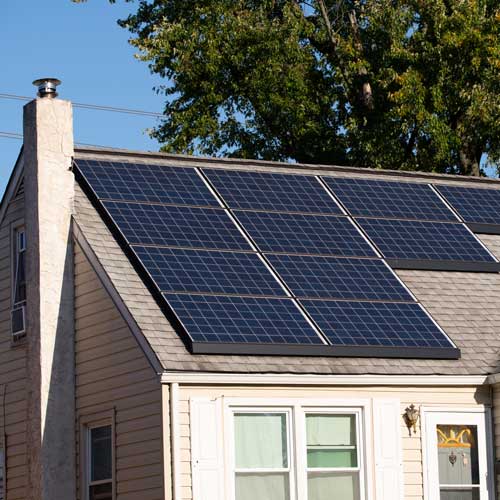Renovus Solar’s primary focus is to save customers money by installing solar energy systems. These systems consist of interconnected technological solutions that convert sunlight into electricity through the Photovoltaic (PV) process. PV modules, made up of small photovoltaic cells, generate electricity and are connected to create an array of modules. The DC power produced by these modules is converted into AC power using an on-site inverter. Depending on the customer’s needs, a solar power system may have four or five components that work together to offset energy bills and promote energy independence.
Solar Panels
When properly installed, solar panels convert the sun’s energy into DC electricity. Sunlight comprises minuscule particles called photons, which radiate from the sun. As these hit the silicon atoms of the solar cell, they transfer their energy to loose electrons, knocking them clean off the atoms.
Freeing up electrons is, however, only half the work of a solar cell: it then needs to herd these stray electrons into an electric current. This creates an electrical imbalance within the cell, which acts like a slope down which the electrons will flow in the same direction. This flow of electrons is the DC current that will be fed into your inverter.
Inverters
When the sunlight hits a solar cell, its photons are converted into electrons of DC electricity. This type of electric current is not directly applicable either at your home or business and cannot be sent through the grid for use elsewhere.
Inverters allow you to convert DC power to AC power, which can be used by your home or transferred back to the grid. Modern inverters are also smart devices that allow solar array owners to monitor their system’s production in real-time.
Utility Meter
A utility meter helps consumers track how much solar power is produced throughout the day. Utility meters are also known as net energy meters. Net meters keep track of the energy you consume and the energy you produce.
Energy credits are applied to your total net energy usage when your system is producing more energy than you are using at that given moment. If your meter is offsite, as with a community solar system, those credits are applied to your bill monthly rather than instantaneously.
Energy Storage
While not all residential and commercial systems have on-site energy storage, they become increasingly more common as industry prices decrease. Energy storage systems are available to anyone who has a solar system, be it in their home or off-site.
Energy storage systems have the dual benefit of allowing consumers to use energy from their battery during peak-pricing hours and store it in case of a grid outage. Batteries are connected directly to a home or business inverter and come in various sizes depending on the consumer’s energy demands.
The Grid
All Renovus solar energy systems are still connected to the grid. The reason for this is that grid-connected systems are both more reliable and easier to maintain for consumers.
The grid can buy back energy from consumers when their systems are overproducing and supply the necessary power to keep a home or business running smoothly when the system is not at peak performance.

